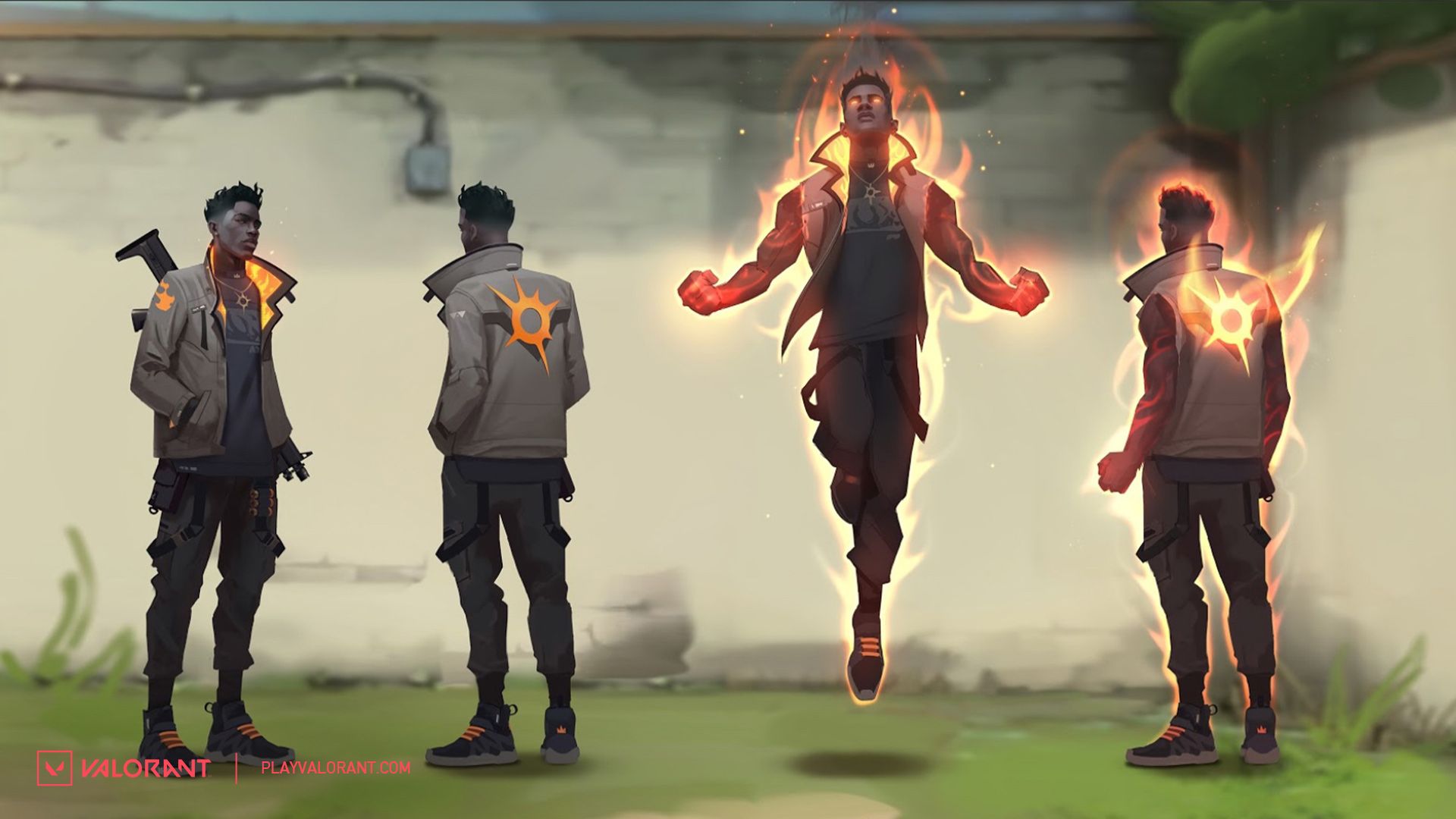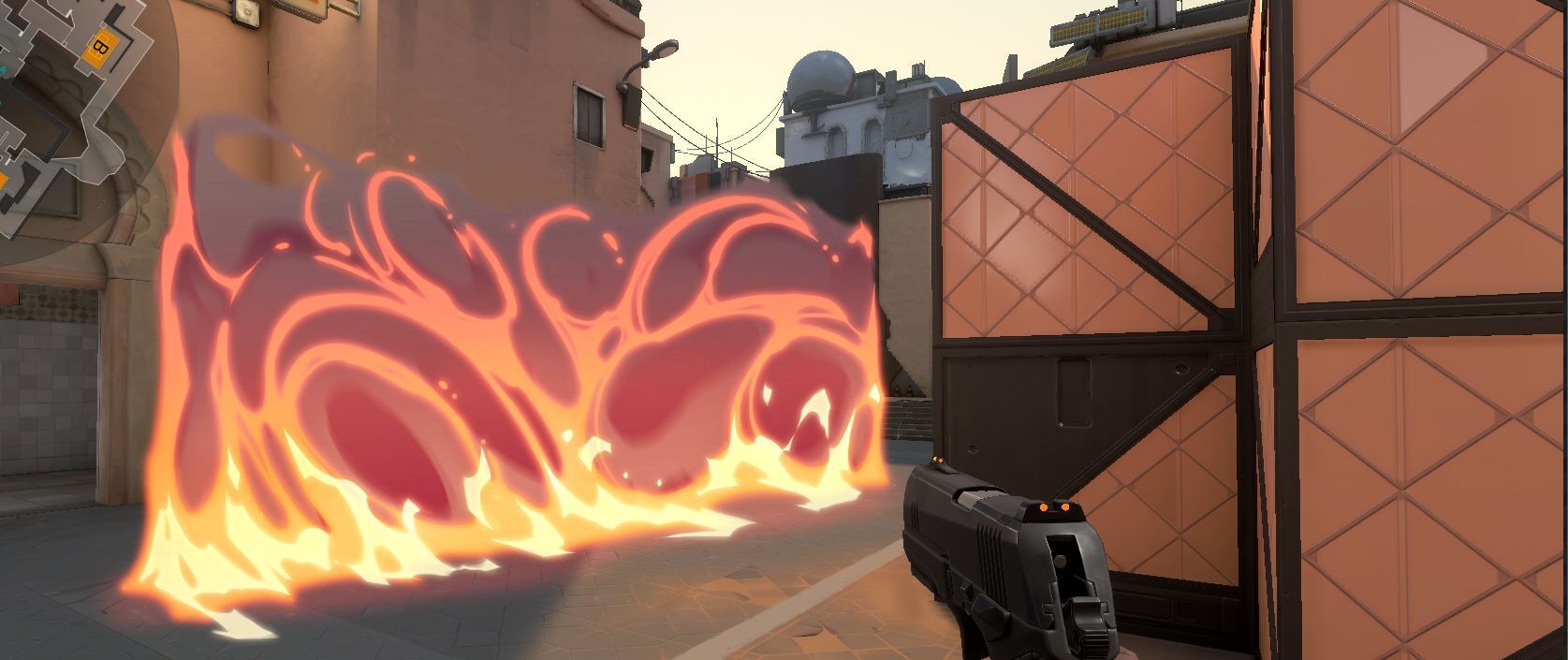AGENT ORIGINS: Phoenix
No defined roles, no flashbang, a forward dash, and a self-res with a period of invulnerability. Back in 2017, Phoenix (and VALORANT) looked pretty different. So how did everyone’s favorite U.K. mad lad turn into the stylish entry-fragger of today? A lot of friggin’ work.
This is the story of Phoenix, VALORANT’s original Duelist.
The First Spark
When most people think of Phoenix, they think of a hyper-aggressive Duelist/Initiator whose sole purpose is to clear sites with style… and a bit of ego. But he didn’t start out that way.
“Phoenix is pretty old. He’s from 2017 or 2018 and predates any concepts of roles,” says Technical Game Designer Bobby “excal” Prochnow. “Back then, it was really very exploratory. Like hey, let’s take a single seed, a single nugget and see where it takes us.”
While Phoenix was always meant to be a character who made his own luck to overcome the numbers against him, his initial seed of an idea morphed quite a bit from on-paper to in-practice.
“Phoenix started with this idea of a back-against-the-wall, last-man-standing character who could fight against all odds. We were trying to capture that essence of what we now call the VALORANT moment. And the ability we were thinking about was his ultimate,” excal shares. “We sort of pictured the ultimate ability where you’d have a second life in some form.”
“We imagined if you popped it, he would revive and it would tick down to 1 hp, but he wouldn’t physically go back to where he started the ult. So you can imagine a 1v5 where you’re at 1hp and you’re dodging all the bullets and getting those 1-taps.’ So I kinda scraped a kit together around that, thinking we were going for this last-man-standing fantasy,” excal continues.
When Phoenix died in this version of his ultimate, he’d go into a state of invulnerability as he was resurrecting, while also still being able to move. Basically, he could push forward and die, react by popping his ult, revive over 3 seconds, and still be able to move back behind cover. This version naturally led to some weird footsies where Phoenix players would try to evade enemies around corners while keeping much of the territory they’d gained.
On paper, Phoenix acting as his team’s last hope really fits his theme—rising from the ashes, putting up a last-stand, giving his team one more chance at a round win. But it didn’t take long for the Character Team to get a feel for his playstyle and make some adjustments to change him from team-martyr to fight-starter.
A final concept of Phoenix’s ultimate ability, Run it Back.
After the first playtest, Phoenix’s ult was redesigned to be used proactively. His job was now to use his ult, know that he’d likely die entering a site, get some entry frags, and revive back at his starting location on death.
“In early tests it became apparent that this is actually an aggressive, gas pedal kind of character who wants to go in first. And I thought, ‘you know what? This kind of works!’ So we embraced that and the kit started to fall into place around that idea,” excal said.
But even with this gas pedal, semi-Duelist idea in place, Phoenix’s abilities still looked pretty different from the ones we know today.
From Dashy to Flashy
At this point in VALORANT's development, roles weren't strongly defined. Duelists didn’t really exist yet, but the team knew they wanted Phoenix to be a self-reliant top-fragger.
“Even though we didn’t have this notion of a Duelist yet, I thought it would be important for this character to be self-sufficient. So out of the gate, we had the duality that this character can hurt with fire but can also heal with fire,” excal explains. “We liked the flexibility with that. Putting up a flame wall, blocking sight lines, and healing while he’s running through it. Or throwing a molly in a close corner and running into it. So we had the wall and the molly right away. It was that other ability slot where we weren’t really sure what to do.”
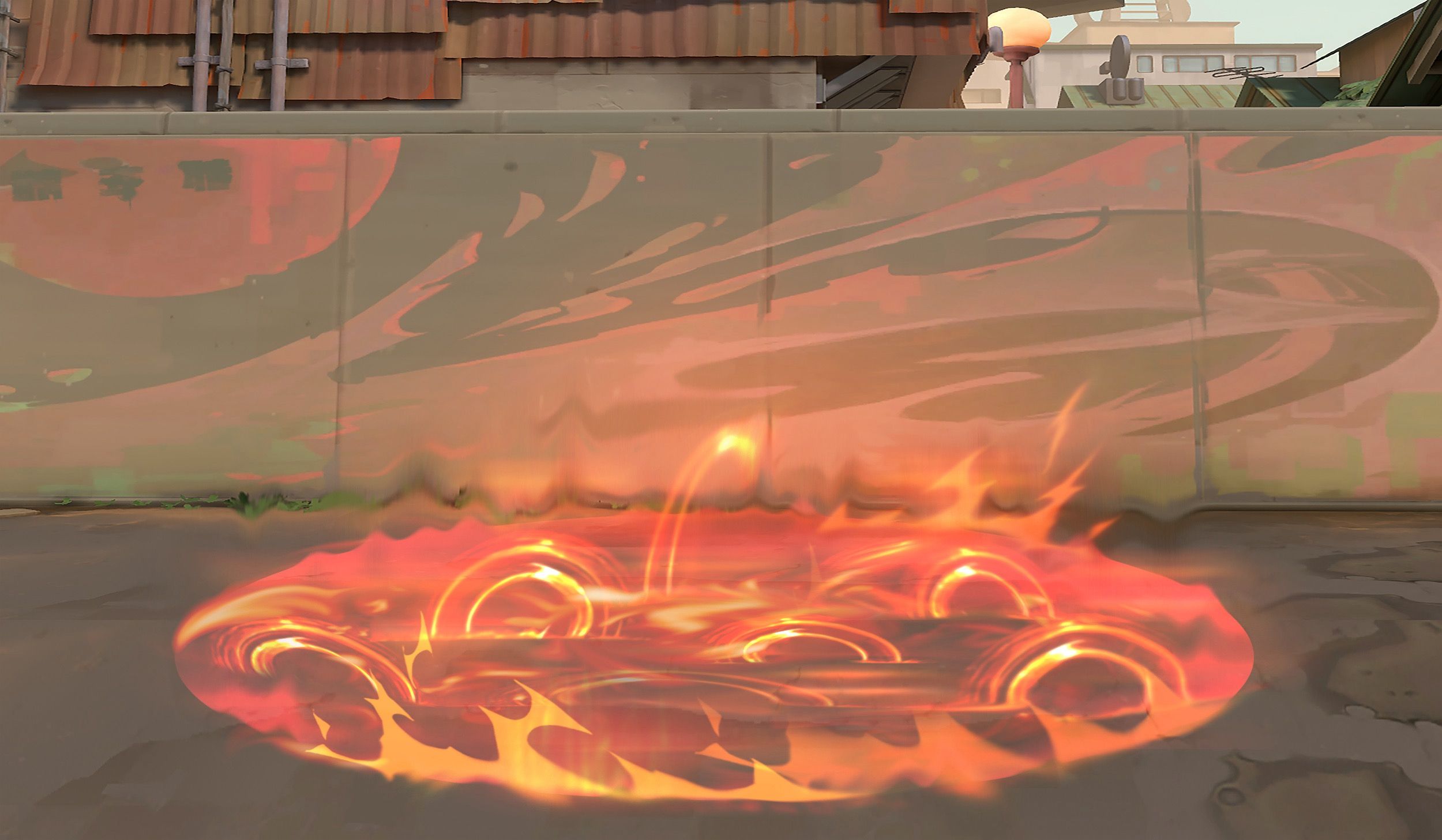
Blaze (top) and Hot Hands (bottom) deployed on the map in an early playtest.
Now, we know what you’re thinking. Obviously, that’s when Phoenix got his Curveball. Because how do you take a site in a tac shooter without a flash? The team knew they needed some kind of flash or blind, but at this point they hadn’t quite decided how flashes would work in VALORANT. Would players be able to buy and equip an actual flashbang grenade? Or would it be an ability some Agents would have?
Yes to the latter... but not quite yet. Rather than giving Phoenix a flash, the team originally tested another idea.
Beyond just site-clearing ability and self-healing, mobility is another key component of any would-be Duelist’s kit. Jett, Reyna, Yoru, Neon, and Raze all have abilities to get in or out of trouble in a hurry. And originally, that’s where the team was headed with Phoenix.
“Phoenix actually used to have a charge dash,” excal reveals. “The gimmick with it was that the longer you charged it, the further he could go. He was punishable the whole time and it was a straight line, so he had to be very proactive about it.”
According to the dev team, it was only a matter of time before folks like Game Designer Nicholas “NickWu” Smith were flying down mid with his dash and rackin’ up the frags. And while this is definitely a fun style of play, it wasn’t quite how the team envisioned Phoenix.
Now let’s pause. Picture yourself on Haven. You’re up 12-11 on attacker side and it’s a 3v1 scenario. It’s looking like “gg ez” is about to start flying in chat when all of a sudden your team starts swinging through C garage and BOOM! Collateral damage. Both teammates are mowed down by an OP through double doors. And to top it all off, the Spike fell forward into the room right between the doors. OOF. If only there was something…
Phoenix needed an ability that would give him more of that flexibility the team was after, rather than a full-on commitment to site. So, the team came up with a bright idea to help Phoenix engage a little more safely.
WATCH YOUR EYES!
“So many other games have utility where you just target it, like Overwatch. And Counter-Strike uses grenade physics. But we wanted to go further than that. That’s where Brim map smokes, Omen’s Shadow Realm, and Jett’s ability to bend her smokes came from,” excal says.
“Originally, Phoenix’s flash went forward. But people had trouble getting it around the wall and out of their line of sight. Because VAL has many of these right angles that you’re always fighting around, it’s very natural to want to just bend it around the wall. It came from a gameplay need more than anything else,” excal adds about Phoenix’s curveball.

A thematic storyboard depicting Phoenix using his Curveball and Blaze abilities.
So there we have it. A flash, a molly, a wall, and a self-revive. Phoenix’s present-day gameplay fantasy was fully formed. Now, it was up to the art and design team to figure out exactly how their new Radiant would look using his fire-bending powers.
(Fun fact: A common question the team is asked is whether or not Phoenix’s Hot Hands ability was designed for Summit1G after his infamous 1v1 should-be-clutch molotov incident. While excal and the team love that idea, the answer is no. Sorry, Summit.)
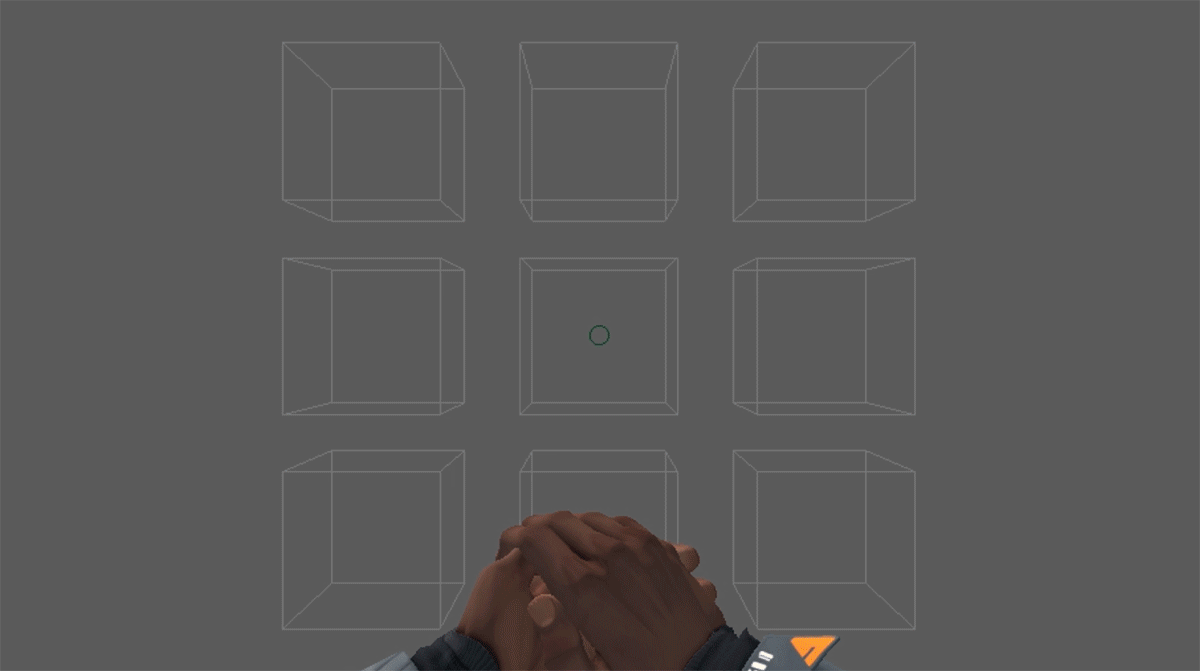
An early version of Phoenix’s Hot Hands projectile. No Summit1G’s were harmed in the making of this ability.
Sun, Not Arson
Fire as a theme is a tricky one. Think of every fire-based character you know in TV, movies, and games. It’s safe to assume that most will skew slightly toward the malevolent side—a little less tactical and a little more, BURN IT TO THE GROUND! So the team wanted to design with intention to keep Phoenix from feeling like an arsonist.
“Phoenix isn’t a pyromancer. He isn’t going to burn the whole site down. He isn’t Viper with fire," excal explains. “In all these other games when you think fire, you’re just gonna be lighting everything up. We’re using fire in kind of a different way here. So we took it lightly more in a solar direction. A solar flare, an eclipse, they’re all blinding. So the intent was trying to button-up that fire into a form that felt less pyro and more controlled.”
So basically, make it as hot as the sun, but keep it from burning everything down. Got it. As one might expect, this level of nuance wasn’t always an easy thing to navigate for the art team.
“From the art standpoint, the solar theme did present some challenges. Fire I think is easy to understand and execute on,” says Senior Manager of 3D Character Art, Minoh “SS_Minnow_2017” Kim. “Solar is a bit like, ‘Gosh, is it fire? Is it light? Magnetic fields? What exactly does this visually look like?’ While challenging, I think overall it helped us to kind of hone him down into a simple, singular thematic.”

It’s easy to see some big solar flare energy in early Curveball renderings.
Fire shouldn’t only fit Phoenix’s kit and ultimate ability’s inspiration. It also needs to match his playstyle and his personality.
John “RiotMEMEMEMEME” Goscicki, senior character producer, explains how those considerations influenced Phoenix’s design: “I think the other thing when it came to the fire and the power there, is leaning into this idea that what you’re doing with Phoenix a lot of times is making these cocky, hot-headed, self-assured plays. You’re doing things that are kind of stupid. So this burning bright, fire theme worked well with his persona.”
Phoen-ishing Touches
Speaking of persona, Phoenix’s personality, wardrobe, and nationality were all hot (sorry, not sorry) topics of discussion as the team started to give VALORANT’s launch roster a final polish before shipping the game.
“Early on, I think the idea was to have him in some kind of fire suit. Like a self-contained thing to keep all of his power managed. He looked like an astronaut almost at first—a futuristic space dude. Then, Concept Lead Larry “TheBravoRay” Ray came on-board with this concept of him as a hip dude. Very much in the vein of some cool dudes from fighting games,” Minoh says. “We also had a couple people on the team that were big into tech-wear. So they were pushing this idea because it looks sort of tactical. They would send us websites that followed that fashion movement, and obviously being tactical is something that works with our game. But this just looked much cooler.”
“And then one day back in April or May of 2019 we sort of trashed all of our previous ideas for the characters,” Minoh adds. “We had a whole different era of art direction. During that time we got rid of a lot of our early Agent concepts and started with a new direction and approach to diversity.”
Like his firebird inspiration, Phoenix’s body (and his original concept art, oops lol) was destroyed and born anew. Concept Artist Josh “LOKKEN” Smith took a fresh approach to TheBravoRay’s initial idea and used it to morph Phoenix into a firestarter of the future. Much of that change occurred during this start-from-scratch reset back in 2019.

A Phoenix portrait study by LOKKEN.
“Basically, before May 2019, we had a roster that wasn’t where we wanted to be in terms of representation. So we had to reapproach it all,” excal says. “It was less of a specific Phoenix decision and more of an, ‘Ok, where do we wanna be? What would actually make sense? And how can we get the roster to a spot where we feel proud of it?’ Phoenix just ended up being a natural choice for some of those changes with this personality and flair and it just all worked really well together with the voice actor.”
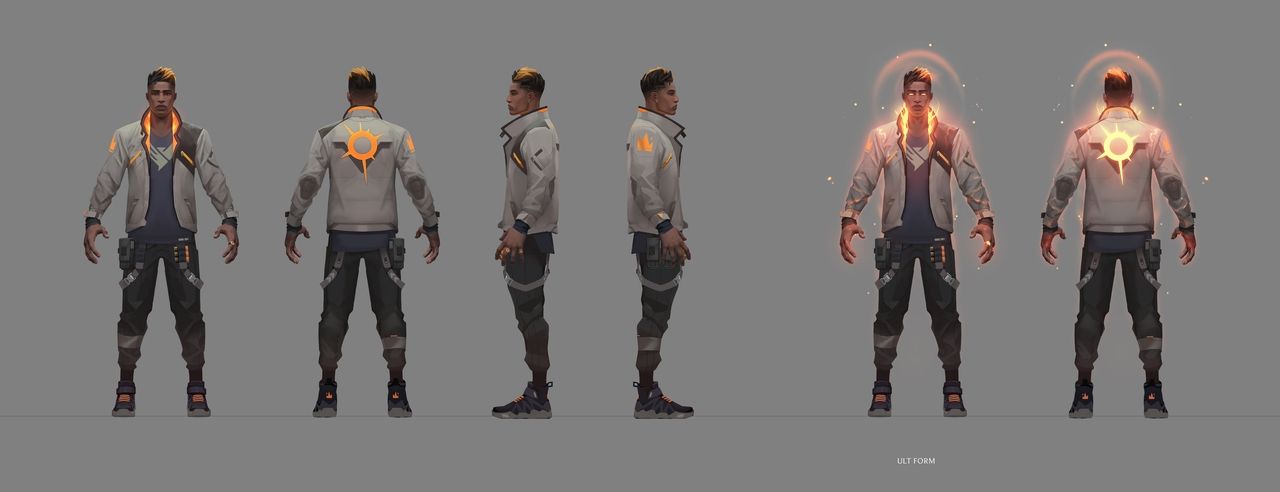
The new art direction for Phoenix that would eventually make it to launch. Solar theme and all.
Diversity and VALORANT’s ‘unapologetically global’ approach was an important philosophy to creating the game. At its core, VALORANT is meant for everyone. The team wanted players of all backgrounds in all regions to be able to run the game with an easily accessible PC min-spec, but also to be able to identify with its cast of characters.
So what better setting for the game than Earth? Err, or like, two Earths—where each Agent can have a real-world home nation to serve as inspiration. And to maintain authenticity, for many launch Agents like Phoenix, a large amount of that inspiration was taken from the voice actors themselves.
“VO Director, David Lyerly, and I sent out the auditions to look for personality, age range, etc.,” says RiotMEMEMEMEME. “And when we got the auditions back for Phoenix, we heard Afolabi Alli and we thought ‘this is the dude.’ So we looked into where he’s from and former narrative writer, Zach Betka, helped tailor Phoenix’s backstory more around that area instead of trying to cast for that particular thing. We try to leave the hyper-specific stuff fuzzy until we cast the actor.”
With the last pieces of the puzzle in place, the powerhouse from Peckham was ready to be revealed to the world. Phoenix was a fan favorite during VALORANT’s closed beta, and became an integral part of the game’s launch with the first lore cinematic, DUELISTS.
But how’s he doing more than two years after release?
Seeing Around Corners
Tactical shooters and competitive games in-general typically have a pulse. They have an ever-evolving meta-game where average players and pro players alike continue to develop their playstyles. So it’s only natural that some Agents and some abilities fall out of favor on occasion. And everyone’s favorite fire boi is no exception to this.
For players who remember the early days of VALORANT, Phoenix’s flash was a menace. A 700 millisecond wind-up felt almost impossible to turn away from. But then, people started learning the game. Curveball’s sound cues and overall timing became more predictable and easier to deal with. Players were able to turn it more easily, and it also didn’t have the same flexibility that the other flashes did, especially on some of the newer, larger maps. And sure enough, Phoenix’s Curveball fell by the wayside to more effective flashes from KAY/O, Skye, and Yoru. Especially in high-level play.
Game Designer Dan “penguin” Hardison explains how the team approached maintaining Phoenix’s viability while leaning into his character fantasy.
“Everything this character does is kinda loud. He’s supposed to get in your face quickly and aggressively. And if he’s dedicating one of his flashes to try to flush out your position, it’s gotta be powerful. It’s gotta be worth using over other flashes. Phoenix needs a tool that excels at punishing targets who are close by, that you can capitalize on yourself. So we knew we had to re-tune his flash. We shortened the time on its wind-up and increased the actual duration of the flash effect.”
So where does that place Phoenix in terms of viability against the rest of the roster?
“According to the data in competitive queue, Phoenix is quite strong after the buff,” penguin shares. “He’s still a bit more range-gated with his flash than someone like Skye, but that’s a good thing. For a Duelist, his flash is very hard to dodge now, debatably too hard to dodge.”
So in the words of the man himself, “Joke’s over. You’re dead!”
